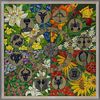Flower EncyclopediaENTER THE WORLD OF FLOWERS |
Other News
Achimenes hybridum
Category: Decorative flowering
23 Jul : 12:41
To view pictures click on them




 Ahimenesat is a small herbaceous perennial plant. Its leaves are oblong, ovoid, dark green with reddish or purple hue, jagged at the edges. Stems and leaves are covered with dense hairs. The colors come from the bosoms of the leaves along the whole length of the stem and a pink velvet violet hue. Profuse and continuous flowering throughout the spring and summer.
Ahimenesat is a small herbaceous perennial plant. Its leaves are oblong, ovoid, dark green with reddish or purple hue, jagged at the edges. Stems and leaves are covered with dense hairs. The colors come from the bosoms of the leaves along the whole length of the stem and a pink velvet violet hue. Profuse and continuous flowering throughout the spring and summer.Ahimenesat (Achimenes) is among the most beloved representatives of the family Gesnerievi. The genus includes about 50 species that inhabit the forests of Mexico, Brazil and Guatemala. Tropical his home and recalls his name, which translated from Greek means "who does not tolerate cold. Nisichki These are plants with a height of 30 cm, with simple or slightly branched stems buried in bright colors. Ampelnite forms reaching up to 50 cm and their leaves are arranged opposite, sometimes 3, like the leaves of nettles, are colored pale green to dark brown. Colors depending on the variety come in different sizes - from 3 to 7 centimeters in diameter, red, pink, blue, purple, white and even yellow. They are single, often grouped in nakolko strand, or hung horizontally positioned. Nevyanka is petdelno, lopatovidno with long flower tube. Heavy flowering occurs from June to November.
Ahimenesite are plants with sharp seasonal nature. They have a mandatory winter rest period of 3-4 months (from November to February). Therefore, at the end of September-October irrigation is reduced and gradually discontinued. Stems wilt and dry and the pot is harvested in dry and cool place (about 14 degrees), where the rootstock is based. In February, imported into the warm room and soon the new show pedicle. Without breaks, ground mass transfer in a large bowl, and stems are bombarded with a finger to the second pair of leaves. Thus, the stem form additional roots and develop a large amount of young klubencheta. Ahimenesite of soil should be light, consisting of leaflet, garden soil and sand in the ratio 6:3:2. Flowerpots placed on the ground with abundant, but scattered light. Direct sunlight can burn the leaves and lack of light leads to deformation of rasteniyata.Ahimenesite are moisture-loving, in the period of vegetation should be watered thoroughly, but be careful not to soil zablati. As they grow and bloom only during the warmer seasons, air humidity in normal room fully satisfy them. Ahimenesat into the light. In the period of growth and flowering is profuse watering and is fed regularly. Ahimenesat and all plants of family Gesnerievi (eg gloxinia) should not be sprayed because the leaves appear brown spots that mar the decorative appearance.
Because of its beauty called "magic flower".
Home of this interesting plant is tropical America - Mexico, Guatemala.
Ahimenesa root system is not large and is placed near the surface, so it is better to be sown in the pots with a thick wide drainage. Earth must be lightweight - a combination of leaflet, peat, manure and sand ugnil. Sprouting started after 8.10 days.
Ahimenesat can also be propagated by dividing the rhizome and leaf through as sentpoliyata example.
Keep it out of direct sunlight and drafts! In order not to damage the tubers in transplanting, distribute them on the soil surface and cover them with more land around 2 centimeters.
| dense hairs purple hue flower tube velvet violet brown colors |
Comments are turned off for this item0
| dense hairs purple hue flower tube velvet violet brown colors |























































